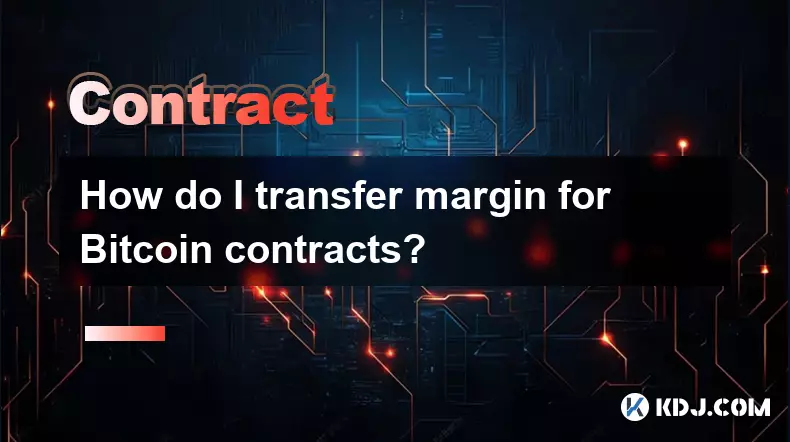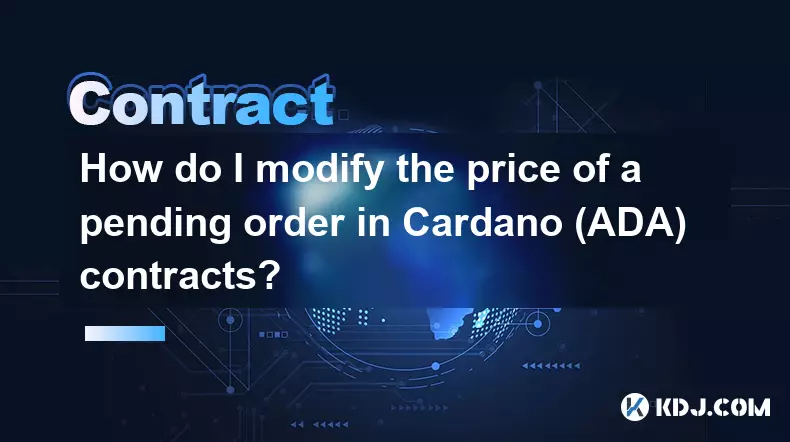-
 bitcoin
bitcoin $109523.663807 USD
-0.13% -
 ethereum
ethereum $4019.526508 USD
2.06% -
 tether
tether $1.000482 USD
0.00% -
 xrp
xrp $2.776815 USD
0.18% -
 bnb
bnb $958.942396 USD
0.12% -
 solana
solana $204.294698 USD
3.84% -
 usd-coin
usd-coin $0.999693 USD
0.00% -
 dogecoin
dogecoin $0.232115 USD
2.09% -
 tron
tron $0.338028 USD
0.84% -
 cardano
cardano $0.790920 USD
1.50% -
 hyperliquid
hyperliquid $44.871443 USD
5.60% -
 ethena-usde
ethena-usde $1.000322 USD
0.04% -
 chainlink
chainlink $21.034165 USD
2.60% -
 avalanche
avalanche $28.794831 USD
-0.54% -
 stellar
stellar $0.360466 USD
1.24%
How do I transfer margin for Bitcoin contracts?
Margin transfer lets traders move funds between spot and futures wallets on exchanges like Binance or Bybit to use as collateral for leveraged Bitcoin contracts.
Sep 27, 2025 at 01:55 pm

Understanding Margin Transfer in Bitcoin Contracts
1. Margin transfer refers to the movement of funds between different trading accounts on a cryptocurrency exchange, particularly between spot and derivatives wallets. When engaging in Bitcoin perpetual or futures contracts, traders must allocate capital as margin to open and maintain positions. This process allows leverage to be applied, increasing both potential gains and risks.
2. Most major exchanges such as Binance, Bybit, and OKX offer an internal transfer system that enables users to shift assets from their spot wallet to their futures or margin wallet. The transferred amount serves as collateral for leveraged trading. Transfers are typically instant and do not incur blockchain fees since they occur within the exchange’s internal ledger.
3. To initiate a margin transfer, users must log into their account and navigate to the wallet or funds section. There, they will find an option labeled “Transfer” or “Assets Movement,” allowing selection between spot and contract accounts. The asset type—usually USDT, BUSD, or BTC—is chosen along with the amount to be moved.
4. Once confirmed via two-factor authentication (2FA), the transfer executes immediately. It is crucial to ensure sufficient margin is allocated before opening a leveraged position, especially when managing active trades exposed to liquidation risks. Some platforms also support automatic margin replenishment features during volatile market conditions.
Step-by-Step Process for Margin Allocation
1. Log in to your preferred cryptocurrency derivatives exchange using secure credentials and enable 2FA for added protection. Navigate to the “Wallet” or “Assets” tab located in the main menu.
2. Within the wallet interface, locate the “Transfer” function. This tool facilitates movement between isolated accounts like Spot, Margin, and Futures. Select the source account—typically “Spot Wallet”—and the destination, which should be “Futures Wallet” or “Contract Account.”
3. Choose the settlement currency used for Bitcoin contracts on the platform. For example, if trading USDⓈ-M futures, select USDT or another supported stablecoin. Enter the exact quantity you wish to transfer. Double-check all details before submission.
4. Confirm the transaction using your secondary authentication method, such as Google Authenticator or SMS code. Upon verification, the funds appear instantly in the target wallet, ready for use in opening leveraged positions.
5. After transferring, proceed to the futures trading interface and select either cross or isolated margin mode based on your risk management strategy. Ensure that the available balance reflects the transferred amount before placing orders.
Risks and Considerations in Margin Management
1. Transferring margin does not guarantee trade success; it only provides the necessary collateral for leverage. Market volatility can lead to rapid price movements that trigger liquidations, especially when high leverage is employed. Traders must monitor their maintenance margin levels closely.
2. Incorrect transfer destinations may delay trading operations or expose funds to unintended strategies. Always verify whether the contract type requires coin-margined (BTC-backed) or USD-margined (stablecoin-backed) positions, as selecting the wrong asset could result in failed transactions or rejected orders.
3. Frequent transfers may indicate poor capital allocation planning. Keeping a dedicated portion of funds in the futures wallet during active trading periods reduces operational friction. However, leaving excessive balances in derivative accounts increases exposure to platform-specific risks such as hacks or insolvency.
4. Some exchanges impose daily transfer limits or temporary restrictions during extreme market events. These controls aim to prevent panic-driven fund movements but can hinder timely margin top-ups. Familiarizing yourself with your platform's policies helps avoid disruptions.
5. While internal transfers are free of network fees, any withdrawal back to an external wallet after trading will incur standard blockchain transaction costs. Plan fund reallocation strategically to minimize unnecessary expenses.
Frequently Asked Questions
What happens if I don’t have enough margin after price movement?If the value of your position moves against you and equity falls below the maintenance margin threshold, the exchange initiates liquidation. A portion or all of your position gets closed automatically to prevent further losses. You may also receive a margin call prompting additional fund transfers to sustain the trade.
Can I transfer margin back to my spot account while holding open positions?Yes, as long as the remaining margin in the futures wallet meets the minimum requirement for open positions. Excess funds beyond what is needed for current leverage and unrealized losses can be transferred back to the spot wallet at any time through the same internal mechanism.
Is there a difference between cross and isolated margin when transferring?The transfer process remains identical, but the impact differs. In isolated margin mode, transferred funds are assigned exclusively to a single position. In cross margin mode, all positions in the same contract type share the entire wallet balance as collective collateral, affecting how margin utilization is calculated.
Do all exchanges allow instant margin transfers?Most reputable exchanges process internal transfers instantly without delays. However, during peak traffic or technical maintenance, slight lags may occur. Always confirm successful completion by checking the updated balance in the destination wallet before executing trades.
Disclaimer:info@kdj.com
The information provided is not trading advice. kdj.com does not assume any responsibility for any investments made based on the information provided in this article. Cryptocurrencies are highly volatile and it is highly recommended that you invest with caution after thorough research!
If you believe that the content used on this website infringes your copyright, please contact us immediately (info@kdj.com) and we will delete it promptly.
- BTC, Hard Fork, and Disputed Futures: A Bitcoin Knots Controversy
- 2025-09-28 01:05:16
- Litecoin, Remittix, and Crypto Payments: A New Era?
- 2025-09-28 01:05:16
- Crypto Presales: Is $BFX the Next Big Thing?
- 2025-09-28 00:25:12
- Kraken's IPO Ambitions: Navigating Valuation in a Recovering Crypto Market
- 2025-09-28 00:25:12
- World Liberty Financial (WLFI): Buyback & Burn Bonanza - Will the Price Ignite?
- 2025-09-28 00:45:12
- Bitcoin's Bumpy Ride: Navigating Risks and Potential Downturns
- 2025-09-28 00:30:01
Related knowledge

How do I enable the "scalping-only" mode for Cardano (ADA) contracts?
Sep 24,2025 at 03:19am
Understanding Scalping Strategies in Crypto Derivatives1. Scalping in cryptocurrency trading refers to executing multiple short-term trades within min...

How do I add margin to Cardano (ADA) contracts?
Sep 27,2025 at 07:54pm
Understanding Margin in Cardano (ADA) Smart ContractsCardano operates on a proof-of-stake blockchain that supports smart contracts through its Plutus ...

What is the maximum position limit for Cardano (ADA) contracts?
Sep 23,2025 at 11:00pm
Understanding ADA Futures and Derivatives Market Structure1. Cardano (ADA) futures contracts are offered by several major cryptocurrency derivatives e...

What is the maker fee for Cardano (ADA) contracts?
Sep 26,2025 at 09:01am
Understanding Maker Fees in Cardano (ADA) Contracts1. The concept of maker fees applies broadly across decentralized exchanges and smart contract plat...

How can I view open interest in Cardano (ADA) contracts?
Sep 24,2025 at 07:36am
Understanding Open Interest in Cardano Derivatives1. Open interest refers to the total number of outstanding derivative contracts, such as futures or ...

How do I modify the price of a pending order in Cardano (ADA) contracts?
Sep 27,2025 at 01:00am
Understanding Pending Orders in Cardano Smart Contracts1. Cardano operates on a proof-of-stake blockchain that supports smart contracts through its Pl...

How do I enable the "scalping-only" mode for Cardano (ADA) contracts?
Sep 24,2025 at 03:19am
Understanding Scalping Strategies in Crypto Derivatives1. Scalping in cryptocurrency trading refers to executing multiple short-term trades within min...

How do I add margin to Cardano (ADA) contracts?
Sep 27,2025 at 07:54pm
Understanding Margin in Cardano (ADA) Smart ContractsCardano operates on a proof-of-stake blockchain that supports smart contracts through its Plutus ...

What is the maximum position limit for Cardano (ADA) contracts?
Sep 23,2025 at 11:00pm
Understanding ADA Futures and Derivatives Market Structure1. Cardano (ADA) futures contracts are offered by several major cryptocurrency derivatives e...

What is the maker fee for Cardano (ADA) contracts?
Sep 26,2025 at 09:01am
Understanding Maker Fees in Cardano (ADA) Contracts1. The concept of maker fees applies broadly across decentralized exchanges and smart contract plat...

How can I view open interest in Cardano (ADA) contracts?
Sep 24,2025 at 07:36am
Understanding Open Interest in Cardano Derivatives1. Open interest refers to the total number of outstanding derivative contracts, such as futures or ...

How do I modify the price of a pending order in Cardano (ADA) contracts?
Sep 27,2025 at 01:00am
Understanding Pending Orders in Cardano Smart Contracts1. Cardano operates on a proof-of-stake blockchain that supports smart contracts through its Pl...
See all articles









































































